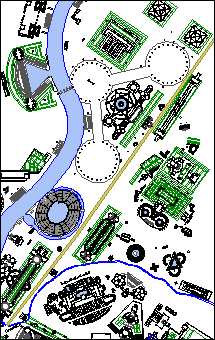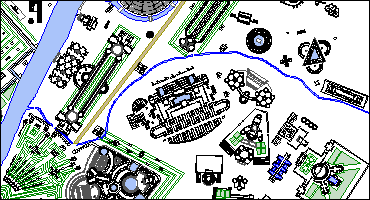Mars (Martis)
1998.07.23
Another of the Ichnographia's three major axes is the race course of the Equiria, the annual horse races held in honor of Mars. Piranesi delineates the course as a relatively straight path running the length of the Ichnographia's northern sector, beginning in the south at the Petronia Amnis (which is, however, incorrectly placed within the plan) and ultimately reaching the outskirts of Rome at the plan's edge. With the exception of a few private gardens on a hill overlooking the Equiria, all the structures along the course relate directly to the Equiria or to the military in general. Three long porticos, the Porticus a S.P.Q.R. Amoenitati Dicata, the Porticus Vipsania, and the Porticus Alexandri Severi, line the course, and no doubt are meant to accommodate the spectators of Rome's premier "fest". The buildings and areas related to the military include, the Officinae Balistarium (manufactory of ballista), Officinae Scorpiorum (manufactory of scorpions), the Naumachia Domitiani (a large amphitheater designed for the show of mock naval battles), three Circulus (large circular areas for military drills and exercises, and finally the Officinae Armorum and the Officinae machinarum militarium (manufactories of military arms and machines). Not only do these buildings pay respect to Mars as the god of war, but, as a cohesive group, they essentially constitute Rome's "Department of Defense".
| |

The Equiria (the broad gold line running from the lower left corner to the upper right corner) spans the Ichnographia's northern region, and the course itself runs in an almost true north-south direction.
|
Petronia Amnis
1998.12.01
amnis : any broad and deep flowing, rapid water; a stream, torrent, river
Petronia : the first wife of the emperor Vitellus
|

The Petronia Amnis of the Ichnographia begins in the east and flows along the southern edge of the Hortulorum valley. Its northern bank in the valley contains the Sepulchrum Agrippae and the Sepulchrum Julii Ceasaris et Drusi, while its southern bank is the ridge of the hill on top of which is the Horti Lucullani and some Turres expugnandae (military assult towers). Eventually, the stream skirts the southern portion of the Equiria and the northern flank of the Bustum Augustii. Ultimately, the Petronia Amnis flows into the Tiber.
| |
The Petronia Amnis of the Ichnographia begins in the east within the valley of the Hortulorum, then skirts the northern flank of the Bustum Augustii, and eventually flows into the Tiber. Piranesi dislocates the Petronia Amnis from its original situation to a more northern position.
Catalogo reference:
Petronia Fiume «Festo lib. 18.» Si dinota nella Tav. 3 coi numeri 16, 17 e 18, e nel suo indice coi medesimi numeri.
|
Although the Petronia Amnis did exist in ancient Rome, Piranesi dislocates the stream to a far more northern position. According to Platner, "there were several swamps or ponds in this low-lying district [the Campus Martius], as well as streams, the largest of which, the Petronia amnis, came from a spring on the Quirinal, called Cati fons, and flowed into the largest swamp, the palus Caprea, or Capreae, where were afterward the pool and baths of Agrippa."¹ There is no real satisfactory explanation why Piranesi chose to move the Petronia Amnis further north of its archeologically correct position, however, the dislocation fits within the same pattern whereby Piranesi moved the Equiria to a more northern position as well. It is as if Piranesi purposefully exaggerated the scope of the Campus Martius in order to present a more availing "reenactment" of Rome's past.
| |
1. Samuel Ball Platner, The Topography and Monuments of Ancient Rome (Boston: Allyn and Bacon, 1904), p 322.
|
| |
Equiria
1998.12.01
Officinae Balistarium
Officinae Scorpiorum
1998.12.01
Ichnographia Quondam: agenda
2000.08.20
|


